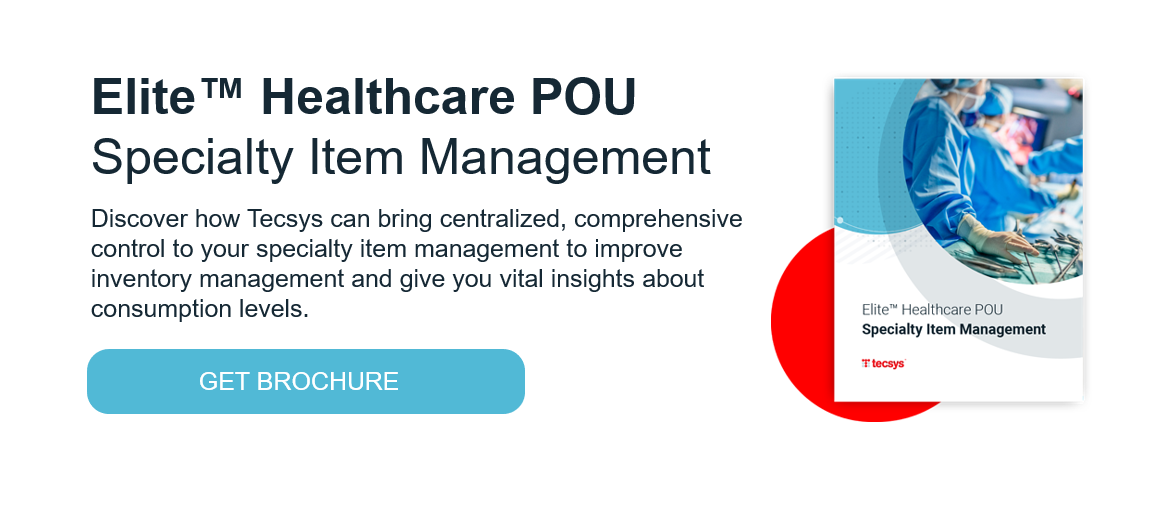Prioritize Patient Care with a Medical Supply Inventory Management Solution

With all of the technology advancements in healthcare supply chain, one area remains highly manual and extremely time-consuming for clinicians — point-of-use (POU) product data capture. It is extremely frustrating and inefficient to have to break away from patient care to input key information such as serial numbers, lot numbers and expiration dates into the electronic health record (EHR), or even worse, write it down on paper to be entered into the system later.
The Dangers of an “OK” Medical Supply Inventory Management System
In many cases, clinicians experience varying levels of success using technology solutions for POU product data capture. For example, supply chain may have promised them that a barcode scanning system would make things easier, only to find it added yet another step to their workflow.
While the more simplistic POU inventory management technologies require clinicians to perform manual work, there are advanced systems that automate processes to eliminate steps. Unlike a one-off standalone tool, a reliable and efficient medical supply inventory management system that is integrated with the EHR streamlines clinician workflows, enabling them to focus on providing quality patient care.
Presenting the Case for a Comprehensive Solution
As a supply chain leader, you recognize the benefits of electronic and automated product data capture at the POU, but how do you convince your organization’s administration, chief nursing officer and other clinicians of its value? How can you help them recognize that this is not just another add-on that will further increase complexities and costs?
To gain trust from clinicians in a POU inventory solution, you must prove that it will help in care delivery. Demonstrate the advantages of a POU medical supply inventory management system and how it can improve the overall healthcare environment, including the clinical relationship with patients.
3 Key Benefits of Implementing a POU Solution
1. Give Time Back to Patient Care
Nurses who have been burned by inefficient technologies in the past will fear that you are only adding to their burden. Show that the new POU inventory system takes away manual processes that would otherwise distract them from their number one priority — the patients. Explain how a system that fits into existing workflows enables them to seamlessly document key product information while they are providing care.
Nurses have a choice on where they work and healthcare leaders are well aware of this. It is in the organization’s best interest to deploy solutions that can help improve nurse satisfaction and retention. When presenting the case for automated and electronic product data capture technology, be sure to describe how it makes it easier for nursing staff to do their jobs.
2. Help Ensure Supply Availability
In the current environment, the importance of supply availability is top of mind for all healthcare stakeholders. We have seen the consequences of running out of personal protective equipment (PPE) and other products, and no one wants to be in that situation ever again.
Having a system in place that automatically captures products during their use, such as RFID “smart” technology, helps prevent stockouts by continuously updating inventory levels. The clinicians and supply chain team know what their facility has in terms of supplies at all times, which drives informed purchasing and medical supply inventory management. It also improves physician preference card accuracy by documenting exactly which supplies were used in a case.
3. Improve Patient Safety and Compliance
The products used on patients have an impact on their care and safety. In the case of an adverse event or recall, clinicians don’t want to have to search through filing cabinets or three-ring binders to determine if impacted products were used on patients in their facility. They also don’t want to run the risk of using expired products.
An automated and electronic POU medical supply inventory management system provides immediate access to data on which supplies were used on which patients during the course of care. This includes information such as lot and serial numbers, which are critical to product tracking in the event of a recall. A comprehensive and integrated system also alerts clinicians of expired items during care delivery to prevent their use on patients.
Next Steps
The implementation of any technology system that impacts clinical processes requires extensive planning and comprehensive change management. If your organization had decided to invest in a POU system, why not select one that can help you achieve all of your clinical and operational goals related to supply inventory?
An effective medical supply inventory management POU system benefits nurses and their patients during care delivery: enabling the nurse to prioritize care, ensuring supply availability and enhancing safety through improved product tracking in the EHR.
As a supply chain leader, start with a strong implementation plan that presents the benefits to administrative and clinical stakeholders. Approval of said plan can then drive improved financial performance for the organization through more effective use of nursing labor resources, greater process efficiency, more accurate charge capture and less supply waste.




